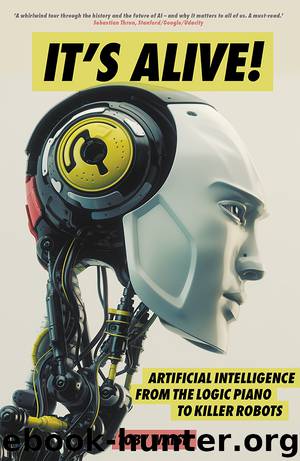It's Alive! by Walsh Toby;

Author:Walsh, Toby;
Language: eng
Format: epub
Publisher: Schwartz Publishing Pty, Limited
Even if we see continual, perhaps even exponential improvements in our Artificial Intelligence systems, this may not be enough to improve performance. The difficulty of the problems that have to be solved before intelligence increases may itself increase even more rapidly.
THE ‘LIMITS OF INTELLIGENCE’ ARGUMENT
Another argument against the technological singularity is the possibility of running into some fundamental limits. Some of these are physical. Einstein taught us that you cannot accelerate past the speed of light. Heisenberg taught us that you cannot know both position and momentum with complete accuracy. Ernest Rutherford and Frederick Soddy taught us that you cannot know with certainty when the radioactive decay of an atom will happen. Any thinking machine we build will be limited by these physical laws. Of course, if that machine is electronic or even quantum in nature, these limits are likely to be much greater than the biological and chemical limits of our human brains. The human brain has a clock speed of dozens of cycles per second. Computers today have clock speeds of billions of cycles per second, millions of times faster. The human brain makes up for this slow clock speed with its massive parallelism – that is, unlike a computer, which processes one instruction at a time, our brains work on many different things at the same time. But even allowing for this, it is remarkable that such a slow machine can do so much. Clearly, computers are likely to have a significant edge in terms of raw clock speed.
However, there are also more empirical laws that emerge out of complex systems. For example, Dunbar’s number is the observed correlation between brain size for primates and average social group size.41 This puts a limit on social groups of between 100 and 250 people. Intelligence is also a complex phenomenon, and may also have limits that emerge from this complexity. Any improvements in machine intelligence, whether it runs away or happens more slowly, may quickly bump up against such limits. Of course, there’s no reason to suppose that our own human intelligence is at or close to this limit. But, equally, there’s little reason why any such limits are necessarily far beyond our own intelligence.
Another limit may simply be due to the inherent uncertainty of nature. No matter how hard you think about a problem, there may be limits to the quality of your decision-making. Even a superhuman intelligence is not going to be any better than the rest of us at predicting the next EuroMillions lottery. Finally, computation is already running into some hard physical limits. The uncertainty of the quantum world limits how small we can build. In March 2016, Intel announced that Moore’s law was ending, and that transistors would only shrink in size for another five years. Intel will now shift its focus to areas such as power consumption, in part to support our appetite for mobile devices.
Download
This site does not store any files on its server. We only index and link to content provided by other sites. Please contact the content providers to delete copyright contents if any and email us, we'll remove relevant links or contents immediately.
Algorithms of the Intelligent Web by Haralambos Marmanis;Dmitry Babenko(8316)
Test-Driven Development with Java by Alan Mellor(6876)
Data Augmentation with Python by Duc Haba(6802)
Principles of Data Fabric by Sonia Mezzetta(6537)
Learn Blender Simulations the Right Way by Stephen Pearson(6442)
Microservices with Spring Boot 3 and Spring Cloud by Magnus Larsson(6301)
Hadoop in Practice by Alex Holmes(5969)
Jquery UI in Action : Master the concepts Of Jquery UI: A Step By Step Approach by ANMOL GOYAL(5818)
RPA Solution Architect's Handbook by Sachin Sahgal(5703)
Big Data Analysis with Python by Ivan Marin(5437)
The Infinite Retina by Robert Scoble Irena Cronin(5401)
Life 3.0: Being Human in the Age of Artificial Intelligence by Tegmark Max(5164)
Pretrain Vision and Large Language Models in Python by Emily Webber(4401)
Infrastructure as Code for Beginners by Russ McKendrick(4172)
Functional Programming in JavaScript by Mantyla Dan(4050)
The Age of Surveillance Capitalism by Shoshana Zuboff(3967)
WordPress Plugin Development Cookbook by Yannick Lefebvre(3884)
Embracing Microservices Design by Ovais Mehboob Ahmed Khan Nabil Siddiqui and Timothy Oleson(3686)
Applied Machine Learning for Healthcare and Life Sciences Using AWS by Ujjwal Ratan(3662)
